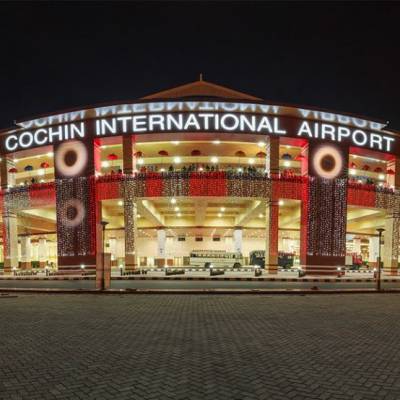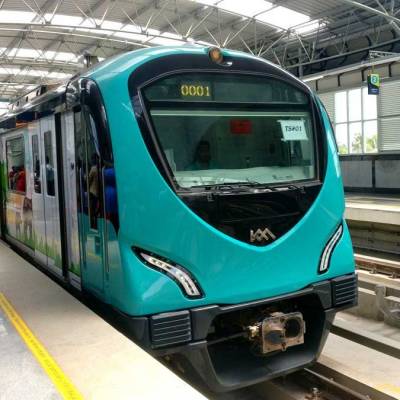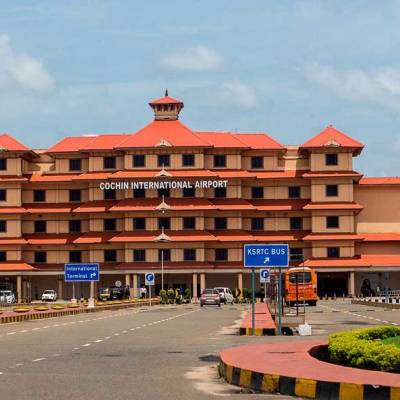- Home
- Real Estate
- The Trendsetter

The Trendsetter
Flying is no longer a luxury. The numbers tell the story. When Cochin Airport in Kerala began operations in 1999, it had only half-a-million passengers; last year, it had 7.7 million. Today, Cochin International Airport Ltd (CIAL) is the fourth largest in terms of international passengers and seventh in terms of total passengers. To cater to the growing demand, this February, Terminal 3, the new international terminal of CIAL, was inaugurated and is now nearing completion.
That´s not all. Cochin Airport has also been in the news for being the world´s first solar powered airport - a case of God´s own country putting India on the global sustainability map. The cost-effective and efficient solar plant began operations last year.
The sustainable path
CIAL first took the path of sustainable development by installing a 100 KWp solar photovoltaic (PV) plant on the rooftop of the arrival terminal block in 2013, becoming a trendsetter in the field of grid-connected solar PV in Kerala. Later, a 1 MWp solar PV power plant was installed in the aircraft maintenance hangar facility. Both these plants are equipped with a SCADA system, through which remote monitoring is carried out.
Inspired by the success of these initiatives, CIAL set up a larger scale 12 MW solar PV plant at $9.5 million; this was inaugurated last year. Around 52,000 units of energy are being generated using the PV solar panels as against the airport´s daily power consumption of around 50,000 units. ´This, along with the previously installed solar power capacity of 1.1 MWp, has made Cochin Airport the first fully solar energy-powered airport in the world,´ shares
AM Shabeer, Executive Director-Engineering Services, Cochin International Airport Ltd.
The solar power project comprising 46,000 panels is spread over 45 acre alongside the cargo complex, which is earmarked for future expansion, perhaps 20 years down the line. Another 10,000-plus panels will be installed in the remaining space to generate an additional 2.40 MW of power. And, CIAL has decided to scale up production to become the world´s largest green energy producer airport. Once the new international terminal becomes operational, power consumption is likely to be doubled, pushing it to about 100,000 units a day.
The brand new terminal
With a built-up area of 15 lakh sq ft, the cost-effective terminal will have a peak hour handling capacity of about 4,000 passengers. Built at about Rs 1,150 crore, the terminal will showcase Kerala´s temple architecture in its facade and is expected to be fully operational soon. With this, the existing international terminal will be converted into the domestic terminal. The new terminal has made use of about nine escalators and 18 elevators. It has an initial parking capacity for about 1,500, which is planned to be extended to 2,500.
Tech specs
CIAL has selected technologies through national-level contracts. ´We don´t have any turnkey contractors; the whole project is divided into different packages,´ shares Shabeer. ´We have prequalified agencies based on the requirements of these packages through national tenders. So, in this exercise, we selected L&T for civil contracting and Sterling & Wilson for MEP works.
Besides these, we have more than 30 contract packages for flooring, glazing, etc. Our contractors have adopted technologies and machineries with current construction practices. So, we have used up-to-date technologies.´
Further, the project features sufficient LEDs for lighting and about 3,000 cameras will be installed in the new terminal. It also has an extensive sewage treatment plant (STP) with an adequate capacity of 750 KLD. Besides, a building management system (BMS) is also being planned for the project.
The terminal has used local materials sourced from the country itself. ´We are importing materials selectively,´ points out Shabeer, ´those not manufactured here include aerobridges and other connected items.´
The terminal building has been constructed with block masonry; for roofing, galvalume sheets have been used. The glass used to build the structure has been sourced from Chennai and includes spider glazing, etc. ´We have used a metallic false ceiling,´ adds Shabeer.
´And, for the flooring, the project has extensively used vitrified tiles of 80 + 80 cm with 12-mm thickness; these have been used for the first time in the country. The entire flooring has used vitrified tiles.´ While a little glazing work has been done for the side walls, ACP cladding has been used for the exterior. The building predominantly features wooden furniture.
Overcoming challenges
Constructing a new terminal in a functional airport is in itself a huge challenge considering public movement. CIAL handled this successfully by isolating the area from other operational areas.
Also, in Kerala, availability of land is scarce and the population density high. Fortunately, Cochin Airport overcame this because it acquired around 1,286 acre in the initial stage itself. This has proved sufficient thus far. However, considering its future expansion plans, it will have to acquire more land. In addition, the state receives rains twice a year, owing to which outdoor activity is a challenge during four to five months. Transportation is another challenge as most materials are imported from other states.
Cochin Airport successfully managed to overcome these and other challenges such as labour issues and scarcity of materials. In fact, there was no lag in the development process and the airport was completed in just about three years.
The long run
The total cost of construction of the new terminal, apron and car park is Rs 1,150 crore. As Shabeer points out, ´Keeping the cost low is the key. And, to keep the cost low, we need a clear idea of what we are building and how we can expand in a modular fashion; so, design is crucial.´
With the airport being the first in the world to be 100 per cent operational on solar energy, it aims to recover the Rs 62 crore spent on the solar plant within six years by supplying excess power to the state at an average cost of Rs 4 per unit. ´We save about Rs 1 crore per month, which means in just about five-and-a-half to six years, we should be able to recover our money,´ adds Shabeer.
Indeed, Cochin Airport is benchmarked by the Airport Economic Regulatory Authority as the most cost-effective airport developed. With its cost-effective systems, solar-powered sustainable approach and a swank new international terminal on the way, Cochin Airport is a true trendsetter.
Project details
Location: Kochi, Kerala
Type: New terminal
Area: 15 lakh sq ft
Total cost: Rs.1,150 crore
Development: In-house
Design and project consultant: Kitco.
Tel: 0484-412 9000.
Website: www.kitco.in
Civil contractor: L&T.
Website: www.larsentoubro.com
MEP: Sterling and Wilson.
Tel: 022-2548 5300.
Website: sterlingandwilson.com
Contracting agencies: 30
To share your views on this report, write in at feedback@ConstructionWorld.in
Benchmarked as the most cost-effective airport developed, the Cochin International Airport is setting new highs with its new terminal and solar status. Flying is no longer a luxury. The numbers tell the story. When Cochin Airport in Kerala began operations in 1999, it had only half-a-million passengers; last year, it had 7.7 million. Today, Cochin International Airport Ltd (CIAL) is the fourth largest in terms of international passengers and seventh in terms of total passengers. To cater to the growing demand, this February, Terminal 3, the new international terminal of CIAL, was inaugurated and is now nearing completion. That´s not all. Cochin Airport has also been in the news for being the world´s first solar powered airport - a case of God´s own country putting India on the global sustainability map. The cost-effective and efficient solar plant began operations last year. The sustainable path CIAL first took the path of sustainable development by installing a 100 KWp solar photovoltaic (PV) plant on the rooftop of the arrival terminal block in 2013, becoming a trendsetter in the field of grid-connected solar PV in Kerala. Later, a 1 MWp solar PV power plant was installed in the aircraft maintenance hangar facility. Both these plants are equipped with a SCADA system, through which remote monitoring is carried out. Inspired by the success of these initiatives, CIAL set up a larger scale 12 MW solar PV plant at $9.5 million; this was inaugurated last year. Around 52,000 units of energy are being generated using the PV solar panels as against the airport´s daily power consumption of around 50,000 units. ´This, along with the previously installed solar power capacity of 1.1 MWp, has made Cochin Airport the first fully solar energy-powered airport in the world,´ shares AM Shabeer, Executive Director-Engineering Services, Cochin International Airport Ltd. The solar power project comprising 46,000 panels is spread over 45 acre alongside the cargo complex, which is earmarked for future expansion, perhaps 20 years down the line. Another 10,000-plus panels will be installed in the remaining space to generate an additional 2.40 MW of power. And, CIAL has decided to scale up production to become the world´s largest green energy producer airport. Once the new international terminal becomes operational, power consumption is likely to be doubled, pushing it to about 100,000 units a day. The brand new terminal With a built-up area of 15 lakh sq ft, the cost-effective terminal will have a peak hour handling capacity of about 4,000 passengers. Built at about Rs 1,150 crore, the terminal will showcase Kerala´s temple architecture in its facade and is expected to be fully operational soon. With this, the existing international terminal will be converted into the domestic terminal. The new terminal has made use of about nine escalators and 18 elevators. It has an initial parking capacity for about 1,500, which is planned to be extended to 2,500. Tech specs CIAL has selected technologies through national-level contracts. ´We don´t have any turnkey contractors; the whole project is divided into different packages,´ shares Shabeer. ´We have prequalified agencies based on the requirements of these packages through national tenders. So, in this exercise, we selected L&T for civil contracting and Sterling & Wilson for MEP works. Besides these, we have more than 30 contract packages for flooring, glazing, etc. Our contractors have adopted technologies and machineries with current construction practices. So, we have used up-to-date technologies.´ Further, the project features sufficient LEDs for lighting and about 3,000 cameras will be installed in the new terminal. It also has an extensive sewage treatment plant (STP) with an adequate capacity of 750 KLD. Besides, a building management system (BMS) is also being planned for the project. The terminal has used local materials sourced from the country itself. ´We are importing materials selectively,´ points out Shabeer, ´those not manufactured here include aerobridges and other connected items.´ The terminal building has been constructed with block masonry; for roofing, galvalume sheets have been used. The glass used to build the structure has been sourced from Chennai and includes spider glazing, etc. ´We have used a metallic false ceiling,´ adds Shabeer. ´And, for the flooring, the project has extensively used vitrified tiles of 80 + 80 cm with 12-mm thickness; these have been used for the first time in the country. The entire flooring has used vitrified tiles.´ While a little glazing work has been done for the side walls, ACP cladding has been used for the exterior. The building predominantly features wooden furniture. Overcoming challenges Constructing a new terminal in a functional airport is in itself a huge challenge considering public movement. CIAL handled this successfully by isolating the area from other operational areas. Also, in Kerala, availability of land is scarce and the population density high. Fortunately, Cochin Airport overcame this because it acquired around 1,286 acre in the initial stage itself. This has proved sufficient thus far. However, considering its future expansion plans, it will have to acquire more land. In addition, the state receives rains twice a year, owing to which outdoor activity is a challenge during four to five months. Transportation is another challenge as most materials are imported from other states. Cochin Airport successfully managed to overcome these and other challenges such as labour issues and scarcity of materials. In fact, there was no lag in the development process and the airport was completed in just about three years. The long run The total cost of construction of the new terminal, apron and car park is Rs 1,150 crore. As Shabeer points out, ´Keeping the cost low is the key. And, to keep the cost low, we need a clear idea of what we are building and how we can expand in a modular fashion; so, design is crucial.´ With the airport being the first in the world to be 100 per cent operational on solar energy, it aims to recover the Rs 62 crore spent on the solar plant within six years by supplying excess power to the state at an average cost of Rs 4 per unit. ´We save about Rs 1 crore per month, which means in just about five-and-a-half to six years, we should be able to recover our money,´ adds Shabeer. Indeed, Cochin Airport is benchmarked by the Airport Economic Regulatory Authority as the most cost-effective airport developed. With its cost-effective systems, solar-powered sustainable approach and a swank new international terminal on the way, Cochin Airport is a true trendsetter. Project details Location: Kochi, Kerala Type: New terminal Area: 15 lakh sq ft Total cost: Rs.1,150 crore Development: In-house Design and project consultant: Kitco. Tel: 0484-412 9000. Website: www.kitco.in Civil contractor: L&T. Website: www.larsentoubro.com MEP: Sterling and Wilson. Tel: 022-2548 5300. Website: sterlingandwilson.com Contracting agencies: 30 To share your views on this report, write in at feedback@ConstructionWorld.in






















